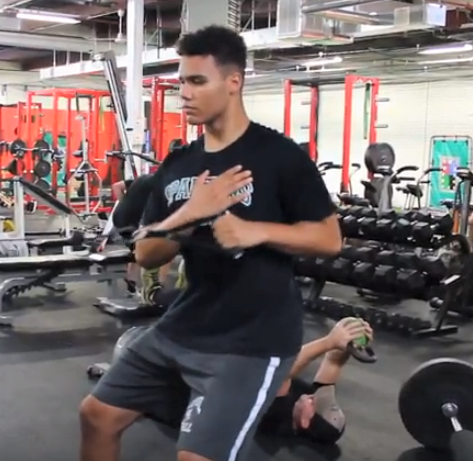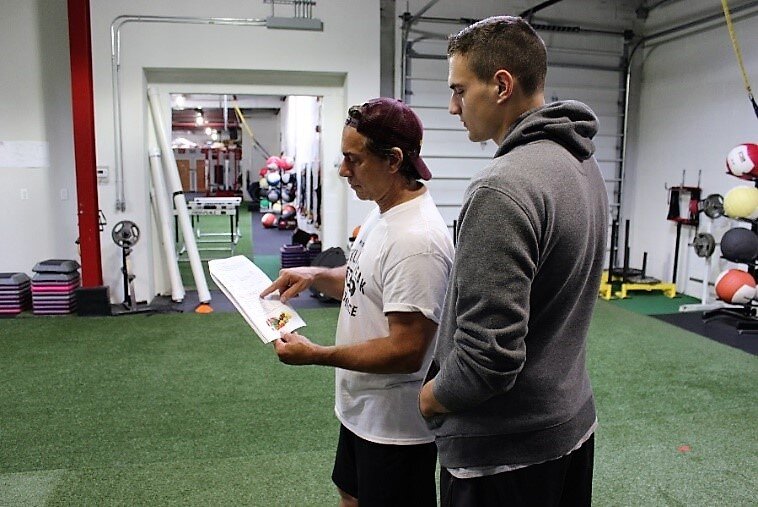
The first trip to the disabled list can leave a young athlete searching for answers. Any athlete worth his weight loves to compete, so when that part of your life gets affected in a negative way, it’s important to get your head together and keep marching. Unfortunately, the “you should just stay out of the weight room for a while” slogan that some (not all!) doctors deliver doesn’t give the athlete much incentive to keep the rest of his body in shape while the injury is healing. After all, we can still make significant improvements in strength without moving the injured limb.
This should make the doctor very happy.
Getting these young athletes to focus on all the things they CAN do while injured, instead of what they CAN’T do, is paramount in order to keep the athlete feeling athletic and get the much needed “buy-in” to help get the ball rolling. Hopefully what this also does is allow time to re-evaluate… and transform.
Let’s look at two such athletes… Paul Cannarella and Nate Byrd, both hard throwers from a very young age (and probably overused because of that), who were coming back from Tommy John surgery not long ago (please note, Paul started training 3 weeks after surgery, his program excluded the injured arm and allowed him to get right into a groove).
Paul Cannarella
-
- Surgery – May 17, 2017
- Start at RPP – June 2017
- Weight:
- Before TJ Surgery – 240 lbs.
- Current Weight – 212 lbs.
- Velocity:
- Before TJ Surgery – 87/88 mph
- Current Velo – Recently touched 91.4 mph and climbing
Nate Byrd
-
- Surgery – October 6th, 2017
- Start at RPP – May 2018
- Weight:
- Before TJ Surgery – 228 lbs.
- Current Weight – 215 lbs.
- Velocity:
- Before TJ Surgery – 87/88 mph
- Current Velo – Recently touched 90.1 mph and climbing
Being that we were going to have these guys in on a regular (4/5 days/week) basis, it allowed us the ability to dig a little deeper into their training process. What we found was that it wasn’t just about rehabbing these guys’ injuries. It was also about:
-
- How do we make their minds and bodies as a whole feel better?
- How do we transfer this into a “new attitude” every time they pick up the ball?
The answer?
Getting them to learn how to get the most out of the predicament, as well as taking better care of their bodies with the ultimate goal of making them a better, more well-rounded athlete.
Attacking the Problem at Hand
Below is an overview of some of the bigger issues we worked on from a programming standpoint during both athletes’ recovery process.
-
- The elbow is a very tight spot with tons of tendons and ligaments all running through and crossing over a very small area. Over time friction can cause them to get very gritty affecting elasticity. So, first and foremost we need to concentrate on soft tissue work to the forearms.
(SMR Tricep / Forearm)
-
- Analyzing pitching mechanics prior to the injury (if available) and locating sub-optimal movement patterns (leaks) in the delivery and addressing them in the weight room (click here).
- Training (early on) the bigger power muscles of the lower half (such as the glutes, hamstrings) while keeping weight out of the athletes’ hands.
(Hip Bridge)
-
- Utilizing “cross-education” (click here), we can attain anywhere from 20-70% of the strength gains of the good arm by incorporating heavy eccentric movements.
(1-arm Cable Row)
-
- Working on increasing strength and firing time of the cuff to help keep the joint in the right position or allow added stress to the elbow. This will also help prevent the cuff from getting overpowered by those bigger prime movers mentioned above.
(Stabilizations / Manual)
-
- Focusing on nutrition and building muscle increased lean body mass (LBM) in both athletes basically putting a bigger engine into the same size body.

-
- Another big ah-ha moment for me was both athletes’ inability to create quick bursts of speed while lifting and sprinting. So, we included plenty of sprinting to help athleticism and flexibility which along with getting leaner and stronger, transferred beautifully over to the mound, increasing both pitchers’ mound velo within 2 weeks of throwing at full intent. Below are recent videos of the guys touching all time highs in their respective velocities.
(Paul Cannarella – 91.4 mph)
(Nate Byrd – 90.1 mph)
And as always, constant re-assessing (around every 6 weeks) to make sure we were heading in the right direction.
Summary
Educating these athletes on arm care and nutrition (lean body mass), fixing mechanics and increasing strength, helped them become more explosive and better prepared athletes than they ever were before their injury. It also showed them what training consistently 3-5 days per week can do for making big gains, from both a body composition and strength and mobility standpoint.
Congrats guys on taking a negative situation and “running with it”.
See ya’ in the gym…
By Nunzio Signore (BA, CSCS, CPT, NASM, FMS)
You live too far to train with us in-house at RPP? You can now train with us on a REMOTE basis.


